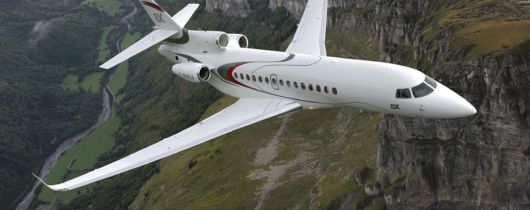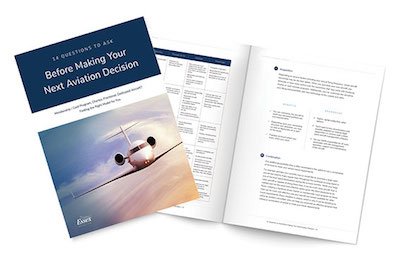
Aircraft leasing is a popular private aviation option for corporate entities and private individuals alike. In order to lease an aircraft, a lessee and lessor must sign an aircraft lease agreement, which defines the terms of the lease, such as who is responsible for operating and maintaining the aircraft, the length of the lease and so on.
For this article, we’ve enlisted the help of David M. Hernandez and Edward K. Gross of Vedder Price, an international business-focused law firm, to explain what aircraft lease agreements are and how they differ depending upon which leasing structure you choose.
The Two Most Common Types of Lease Structure
There are two primary types of aircraft lease structure:
Traditional Ownership Structure Lease
Also known as an operating lease, the owner (either a business or an individual) acquires an aircraft and sets that aircraft up as its own legal entity, typically a limited liability company (LLC). The LLC will often enter into a lease agreement with the actual intended operator of the aircraft — usually the original buyer — so that they can use the aircraft. This prevents the LLC from being considered a prohibited flight department company. From there, the LLC — which legally owns the aircraft — may also enter into an aircraft management agreement with a management company. The management company is responsible for managing the aircraft on behalf of the owner, as well as operating the aircraft for third-party commercial charters. Some owners decide not to hire a management company and instead elect to hire their own pilots and maintenance personnel.
There are a number of reasons why an aircraft owner might create a traditional ownership leasing structure, including for tax purposes, for privacy or to comply with Federal Aviation Administration (FAA) regulations. Many owners choose to take advantage of what is referred to as “sale for resale” state tax exemptions; this exemption enables the owner to spread sales tax across lease payments, rather than pay in full at closing. Some owners would prefer that their company name not be listed on the FAA registry and would, therefore, rather use an LLC as the registered owner of the aircraft.
Finally, the FAA prohibits entities from charging for the use of the aircraft and prohibits single member entities from owning and operating an aircraft; this is commonly referred to as the “flight department company trap.” As a result, some companies will set up an LLC as a leasing company and lease the aircraft to the actual operator.
Financing Lease
A financing lease is essentially an acquisition financing product and is an alternative to a secured loan. For the sake of simplifying things, you can think of lease financing as being similar to loan financing.
In this arrangement, a financial institution will take ownership of the aircraft and enter into a lease agreement with a business or individual. This is essentially an acquisition structure that doesn’t require the actual purchase by the lessee of a plane, meaning the lessee doesn’t have to carry the aircraft on its balance sheet.
We refer to these acquisition financing transactions as “leases” for tax, accounting and commercial law/bankruptcy purposes. The lessor assumes all of the market value risks and benefits associated with ownership, especially regarding the value of the aircraft after lease expiration, and it allocates the “net” lease responsibilities (discussed below) to the lessee under the lease terms.
In the past, banks were typically the lessors in these financings, however, the number of banks that offer true (tax) leases has significantly diminished since the 2008 recession. Those interested in pursuing a financing lease structure are more likely to find opportunities working with an equity investor.
The Different Types of Aircraft Lease Agreement
The terms of an aircraft lease agreement changes depending on which leasing structure you choose to pursue.
Traditional Ownership Structure Lease
A typical traditional leasing structure often involves related parties. However, there are situations in which a traditional leasing structure would involve unrelated parties, in which case the lessee would be required to obtain pilot management services from an unrelated entity. It’s important to note that lessors cannot provide the aircraft and a pilot in a traditional ownership structure lease because that is considered a “wet lease” and generally requires an FAA Air Carrier certificate. The use of a time sharing agreement, under the Federal Aviation Regulations (FAR) Part 91.501, is a limited exception to this rule.
Financing Lease
As mentioned, a financing lease is an acquisition financing product, so it is appropriate to compare it to a purchase money loan. Similar to a secured loan, the lessor finances the lessee’s prospective acquisition, however, the lessor advances 100% of the purchase price and the lessee’s payments are reduced to reflect the lessor’s tax and residual value assumptions; the lessee typically has flexibility to purchase the aircraft upon lease expiration or, perhaps, to extend the lease term.
Put simply, the aircraft lease agreement for a financing lease is similar to a loan agreement; so long as the lessee pays installments and materially performs any other obligations under the lease, the lessor won’t interrupt the lessee’s use and operation of the aircraft during the lease term. The key difference between a financing lease and a secured loan is that the lessor assumes on the market value risk at lease expiration.
Components of a Standard Aircraft Lease Agreement
Let’s take a closer look at the basic components that an aircraft lease agreement structure should include, including general terms, starting with a traditional ownership lease.
Traditional Ownership Structure Lease
It’s uncommon for a bank or lender to be involved in a traditional leasing structure unless the situation were to call for both a traditional ownership lease and a financing lease. In a traditional leasing structure, FAA regulations require both the lessor and the lessee to obtain pilot management services from an independent third party. A lease without the provision of pilot services is considered a “dry lease,” whereas a lease with an aircraft and pilot is considered a “wet lease” and requires FAA certification. The vast majority of traditional ownership leases that people enter into are dry leases.
Those interested in a traditional leasing structure should be aware that the FAA takes dry lease abuses very seriously and has aggressively pursued enforcement action against entities entering into fraudulent dry leases. Any entity that requires the lessee to use a specific set of pilots when leasing the aircraft is a de facto wet lease, and therefore requires an air carrier operating certificate; this ultimately subjects the lessor to less risk of enforcement action and civil penalties.
As far as general terms are concerned, any aircraft lease agreement for a traditional leasing structure should clearly specify which entity has operational control, performs maintenance, provides insurances and is generally responsible for the care of the aircraft while it is in the lessee’s possession. The lease agreement should also address all relevant aspects of the aircraft’s care and operation, including default provisions, choice of law, permitted use, return provisions and maximum hours of operation. Additionally, the lessor should reserve the right to inspect the aircraft if it is leased to unrelated entities.
Financing Lease
With a financing lease, the structure of the aircraft lease agreement will take into account whether the lessor is going to lease finance a new or pre-owned aircraft.
If the lessor is lease financing a new aircraft, the lessee must assign its right to purchase the aircraft from the original equipment manufacturer (OEM) and, in some cases, to make progress payments due under the purchase agreement. If the lessor chooses to finance these progress payments, it will pay the balance of the purchase price to the OEM upon delivery, take ownership of the aircraft title and lease the aircraft to the lessee.
If the lessor is lease financing a pre-owned aircraft, the purchasing process is essentially the same, except for the fact that it is generally less time and cost-efficient than purchasing from the OEM, and the lessor doesn’t finance pre-delivery payments. If the transaction is a refinancing, it will be structured as a sale and leaseback, pursuant to which the lessor purchases the aircraft from and leases it back the lessee. This would necessitate an aircraft purchase and leaseback agreement.
In any case, once the purchase is complete, the lessee accepts the aircraft under the lease for the negotiated rent, term and certain lease expiry options. In some cases, the lessor might require additional support from the lessor in the form of a guarantee, deposit or other non-aircraft collateral.
The essential promise the lessee makes is that, upon acceptance, the lessee cannot cancel the lease and is obligated to pay the rents and other amounts listed under the lease come “hell or high water.”
These leases are typically “net” leases, meaning that the lessee agrees to pay all costs associated with owning, operating, maintaining, servicing, insuring and registering the aircraft, as well as all related taxes. Essentially, the lessee bears all risks associated with ownership, other than decline in the market value of the aircraft. The aircraft lease agreement will include a number of requirements and restrictions to ensure the safe operation and condition of the aircraft. By way of example, the lessee will be required to indemnify the lessor against liability claims, state taxes and loss of lessor’s anticipated tax benefits.
Although the lease is typically non-cancellable by the lessee, should the aircraft suffer a casualty, the lessee is required to pay the lessor the agreed value of the aircraft, determined at lease inception. Aside from a casualty, some financing leases might also permit the lessee to terminate the lease and purchase the aircraft from the lessor or otherwise make the lessor whole.
Most bank lessors are “credit” lenders, so the lease is likely to include credit covenants, cross-defaults and reporting requirements similar to what might be included in a credit facility agreement. At lease expiration, the lessee must either return the aircraft according to certain conditions set out in the lease, purchase the aircraft for (at least) fair market value or renew the term for (at least) fair market rental value.
Drafting an Aircraft Lease Agreement
The process of drafting an aircraft lease agreement is as follows:
Traditional Ownership Structure Lease
The most important aspects of drafting and negotiating a lease are understanding the goals and expectations of the parties involved and knowing which parties will be responsible for the care, maintenance and insurance of the aircraft. There should be no confusion as to:
- Who will perform maintenance
- Who will be responsible for payment of maintenance service plans
- How the aircraft will be returned
- What the termination provisions are
- What notice is required
Every aspect of the use, operation and return of the aircraft should be addressed. The aircraft lease agreement should also address what happens in the event of any non-compliance or default, particularly in the case of unrelated parties.
Financing Lease
The credit approval process for a financing lease starts with the lessor conducting due diligence regarding the lessee/guarantor and the aircraft in question. From there, the lessor and lessee will create a term sheet, with the lessor covering financing terms, requirements of the lessor’s credit committee and so on. The lessor will then provide lease documents reflecting what was proposed in the term sheet, with all important details and/or agreed adjustments to the proposed terms.
Next, the lessor and lessee will incorporate various terms reflecting the lessee’s ownership structure and operational expectations into the lease documents. Deliverables are then collected, and closing deliverables and action items are attended to. Assuming all concerned parties are satisfied, the lessor pays the purchase price to the OEM or seller, and the lessee accepts the aircraft under the lease agreement.
—
An important note: Given the significant investment of private aircraft and the potential for FAA, IRS and insurance violations, it’s in your best interest to retain a team of knowledgeable professionals to help you navigate this complex process. Regardless which leasing structure you choose, your team should include:
- An experienced business aircraft finance attorney
- A private aviation consultant
- A broker
- An OEM or other seller
- An insurance broker
- A management company or charter operator
- A maintenance program provider
- An aviation experienced accountant or tax advisor
- An FAA registration counsel and/or title company
Key Aircraft Lease Agreement Considerations
A few things to keep in mind before entering into an aircraft lease agreement:
Traditional Ownership Structure Lease
- The primary consideration is using the aircraft to its maximum operational capability consistent with the client’s wishes without violating any FAA or IRS regulations and insurance provisions. This requires full knowledge of exactly what each party wants to do with the aircraft within the limitations of those regulations and provisions.
- In accordance with the previous consideration, it’s imperative to understand the applicable FAA, IRS and insurance requirements to ensure that owners are able to operate the aircraft as they need. It’s best practice to discuss operational considerations with the management company.
- If the aircraft being leased under a traditional lease is being financed, all usage and other terms must be approved by, and subject to the rights of, the financing party; this is known as “consent.”
Financing Lease
- The terms and pricing, including rent, will be driven by the aircraft’s value, operational and maintenance expectations, the creditworthiness of the lessee and any customer relationship with the lessee.
- Some lessors — banks, in particular — are more conservative as to whom they’ll provide lease financing. Other lessors, especially equity investors, are asset financiers and are therefore less risk-averse; that said, that risk acceptance will be reflected in their pricing.
- Experienced and sophisticated lessors and lessees will have sorted out most of what they deem essential in the term sheet in order to avoid unnecessary investments of the time and legal costs required to put together a transaction that isn’t a good fit for either party.
- It’s important that lessees take a thorough and thoughtful approach not only to the proposed economics of the transaction, but also to purchase, operation, management, regulatory and tax considerations.
- Lessees must fully disclose all information that might be pertinent to the lessor’s willingness to lease the aircraft pursuant to what’s been proposed in the term sheet.
- The financing proposed in the term sheet must be practical and likely to be approved by the lessor’s credit committee well before the scheduled closing.
Renegotiating an Aircraft Lease Agreement
There are some instances in which it might make sense for a lessee to renegotiate or otherwise restructure an existing aircraft lease.
Traditional Ownership Structure Lease
Whether the parties involved want to renegotiate the lease depends entirely on their relevant and respective needs and whether there are issues that require renegotiation. Given that related party leases are typically handled internally, there are rarely any issues. However, an unrelated party lease could involve a wide variety of issues, including payment issues, operational issues or default provisions. Therefore, it’s imperative that all leases address how to make modification amendments and define applicable resolution provisions.
Lessees are advised to be wary of any entity attempting to offer a lease as a viable alternative to a charter arrangement. The FAA is severely cracking down on such corrupt operations and has pursued multiple enforcement actions over the past two years.
The most important thing here is that all parties understand the terms and conditions of the lease. It’s inadvisable to sign a lease and worry whether you can comply with the terms after the fact. The lessee should always know exactly what they are responsible for under the lease and what the termination and default provisions are.
Financing Lease
Financing lease pricing is based on interest rates and market values. If there is a significant change in either or both, or if the lessee’s needs have changed and they intend to trade up through another lease with the same lessor, the lessee may be able to restructure the lease.
Non-bank lessors are likely to be receptive to restructuring requests. Banks that offer leasing products are more likely to be receptive toward restructuring if the lessee is a desirable customer or if they intend to extend the lease at a time when the actual aircraft value is likely to be less than the assumed value at lease inception.
It’s important that both parties remain aware as to when it might be mutually beneficial to renegotiate or restructure the terms of the lease.
What to Know Before You Sign an Aircraft Lease Agreement
In order to expediently close a deal, it’s critical that lessees fully disclose expectations and other relevant information and be responsive to the lessor. In the case of a financing lease, having an existing banking relationship with the lessor could streamline the approval process and result in friendlier economic terms.
Lease financing for a desirable customer can be competitive; in such situations, lessees should prioritize the reliability of the financing provider over proposed financing rates and costs. To that end, lessees should place more weight on a lessor’s ability to close a transaction in a timely manner and their documentation or closing requirements than on whether they offer favorable economic terms.
Finally, in order to achieve all of their goals related to acquiring, financing and operating a new or pre-owned aircraft, lessees should retain the services of industry professionals with relevant experience and favorably recognized market reputations. This includes retaining legal counsel from a firm such as Vedder Price and advisory services from a private aviation consulting firm such as Essex Aviation.
For more information on aircraft leasing and other private aviation services, please contact Essex Aviation today.







